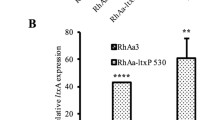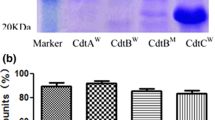Abstract
Aggregatibacter actinomycetemcomitans is a gram negative bacterium and an infectious agent of human diseases with severe oral and extra oral manifestations. One of the major virulence factors in this microorganism is cytolethal distending toxin (CDT). This toxin consists of three subunits—A, B, and C and is able to disrupt cell cycle by intrinsic DNAse activity of its B-subunit. Due to the fact that this protein can represent an important component of diagnostic, prophylactic and therapeutic preparations, production of CDT subunits in preparative quantities is of considerable practical importance. In the current study we demonstrated that deletion of NH2-terminal regions from the molecules of CDT-A, -B, or -C resulted in 20–400-fold increase in production of the corresponding subunits. These truncated molecules were used as immunogens to raise monospecific sera, which were shown in western blot to react specifically with the homologous subunits of cytolethal distending toxin.






Similar content being viewed by others
References
Akifusa S, Poole S, Lewthwaite J, Henderson B, Nair SP (2001) Recombinant Actinobacillus actinomycetemcomitans cytolethal distending toxin proteins are required to interact to inhibit human cell cycle progression and to stimulate human leukocyte cytokine synthesis. Infect Immun 69:5925–5930
Belyi Y, Niggeweg R, Opitz B, Vogelsgesang M, Hippenstiel S, Wilm M, Aktories K (2006) Legionella pneumophila glucosyltransferase inhibits host elongation factor 1A. Proc Natl Acad Sci U S A 103:16953–16958
Belyi Y, Tabakova I, Stahl M, Aktories K (2008) Lgt: a family of cytotoxic glucosyltransferases produced by Legionella pneumophila. Infect Immun 190:3026–3035
Boesze-Battaglia K, Brown A, Walker L, Besack D, Zekavat A, Wrenn S, Krummenacher C, Shenker BJ (2009) Cytolethal distending toxin-induced cell cycle arrest of lymphocytes is dependent upon recognition and binding to cholesterol. J Biol Chem 284:10650–10658
Bradford MM (1976) A rapid and sensitive method for the quantitation of microgram quantities of protein utilizing the principle of protein-dye binding. Anal Biochem 72:248–254
Cao L, Volgina A, Huang CM, Korostoff J, DiRienzo JM (2005) Characterization of point mutations in the cdtA gene of the cytolethal distending toxin of Actinobacillus actinomycetemcomitans. Mol Microbiol 58:1303–1321
Cao L, Bandelac G, Volgina A, Korostoff J, DiRienzo JM (2008) Role of aromatic amino acids in receptor binding activity and subunit assembly of the cytolethal distending toxin of Aggregatibacter actinomycetemcomitans. Infect Immun 76:2812–2821
Ge Z, Schauer DB, Fox JG (2008) In vivo virulence properties of bacterial cytolethal-distending toxin. Cell Microbiol 10:1599–1607
Henderson B, Nair SP, Ward JM, Wilson M (2003) Molecular pathogenicity of the oral opportunistic pathogen Actinobacillus actinomycetemcomitans. Annu Rev Microbiol 57:29–55
Kolodrubetz D, Dailey T, Ebersole J, Kraig E (1989) Cloning and expression of the leukotoxin gene from Actinobacillus actinomycetemcomitans. Infect Immun 57:1465–1469
Laemmli UK (1970) Cleavage of structural proteins during the assembly of the head of bacteriophage T4. Nature 227:680–685
Mao X, DiRienzo JM (2002) Functional studies of the recombinant subunits of a cytolethal distending holotoxin. Cell Microbiol 4:245–255
Matangkasombut O, Wattanawaraporn R, Tsuruda K, Ohara M, Sugai M, Mongkolsuk S (2010) Cytolethal distending toxin from Aggregatibacter actinomycetemcomitans induces DNA damage, S/G2 cell cycle arrest, and caspase-independent death in a Saccharomyces cerevisiae model. Infect Immun 78:783–792
Nesic D, Hsu Y, Stebbins CE (2004) Assembly and function of a bacterial genotoxin. Nature 429:429–433
Nishikubo S, Ohara M, Ueno Y, Ikura M, Kurihara H, Komatsuzawa H, Oswald E, Sugai M (2003) An N-terminal segment of the active component of the bacterial genotoxin cytolethal distending toxin B (CDTB) directs CDTB into the nucleus. J Biol Chem 278:50671–50681
Shenker BJ, McKay T, Datar S, Miller M, Chowhan R, Demuth D (1999) Actinobacillus actinomycetemcomitans immunosuppressive protein is a member of the family of cytolethal distending toxins capable of causing a G2 arrest in human T cells. J Immunol 162:4773–4780
Slots J, Ting M (1999) Actinobacillus actinomycetemcomitans and Porphyromonas gingivalis in human periodontal disease: occurrence and treatment. Periodontol 2000 20:82–121
Sugai M, Kawamoto T, Peres SY, Ueno Y, Komatsuzawa H, Fujiwara T, Kurihara H, Suginaka H, Oswald E (1998) The cell cycle-specific growth-inhibitory factor produced by Actinobacillus actinomycetemcomitans is a cytolethal distending toxin. Infect Immun 66:5008–5019
Towbin H, Staehelin T, Gordon J (1979) Electrophoretic transfer of proteins from polyacrylamide gels to nitrocellulose sheets: procedure and some applications. Proc Natl Acad Sci U S A 76:4350–4354
Ueno Y, Ohara M, Kawamoto T, Fujiwara T, Komatsuzawa H, Oswald E, Sugai M (2006) Biogenesis of the Actinobacillus actinomycetemcomitans cytolethal distending toxin holotoxin. Infect Immun 74:3480–3487
van Winkelhoff AJ, Slots J (1999) Actinobacillus actinomycetemcomitans and Porphyromonas gingivalis in nonoral infections. Periodontol 2000 20:122–135
Wren BW, Tabaqchali S (1987) Restriction endonuclease DNA analysis of Clostridium difficile. J Clin Microbiol 25:2402–2404
Yamada T, Komoto J, Saiki K, Konishi K, Takusagawa F (2006) Variation of loop sequence alters stability of cytolethal distending toxin (CDT): crystal structure of CDT from Actinobacillus actinomycetemcomitans. Protein Sci 15:362–372
Acknowledgments
We wish to thank Dr. Annette Wittmer and Dr. Barbara Waidner, Department of Microbiology and Hygiene, Institute of Medical Microbiology and Hygiene, University of Freiburg, Freiburg, Germany, for A. actinomycetemcomitans strains. Sequence determinations have been done in the “Genome Centre” IMB RAS, Moscow, Russia (http://www.genome-centre.narod.ru/).
Author information
Authors and Affiliations
Corresponding author
Rights and permissions
About this article
Cite this article
Vertieva, E., Kobozev, M., Tartakovskaya, D. et al. Genetic constructions, hyperexpressing recombinant fragments of cytolethal distending toxin of Aggregatibacter actinomycetemcomitans . World J Microbiol Biotechnol 27, 1189–1196 (2011). https://doi.org/10.1007/s11274-010-0567-4
Received:
Accepted:
Published:
Issue Date:
DOI: https://doi.org/10.1007/s11274-010-0567-4




